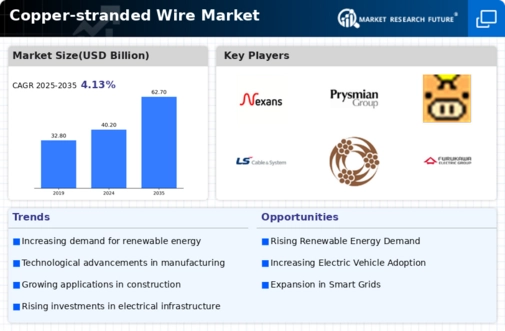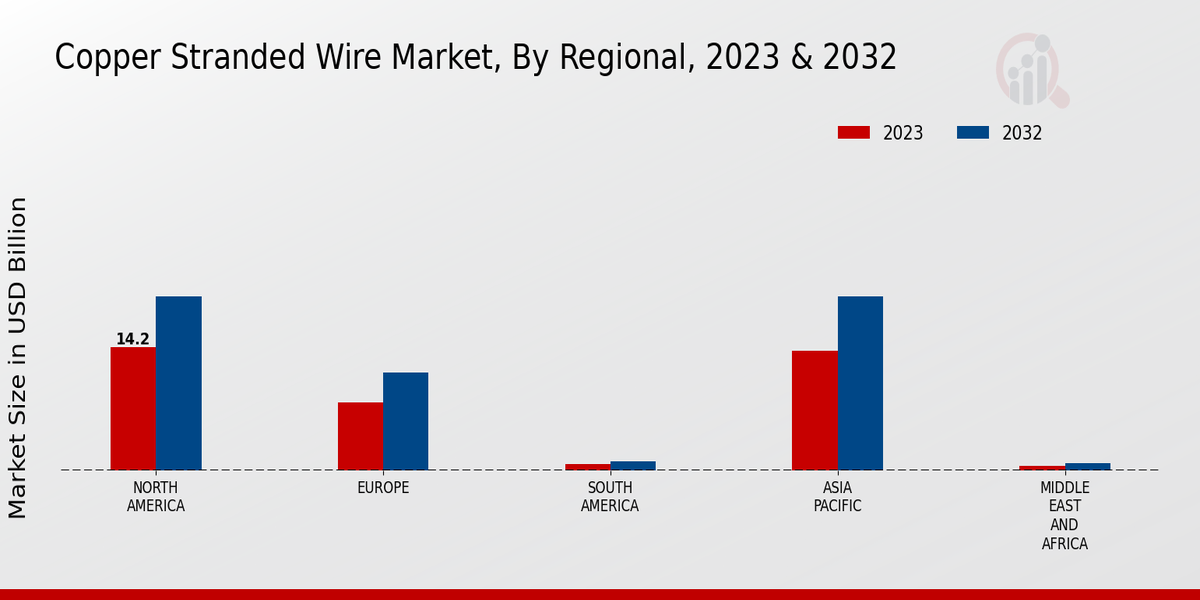Market Growth Projections
The Global Copper-stranded Wire Market Industry is projected to experience substantial growth in the coming years. With a market value of 40.2 USD Billion in 2024, it is expected to reach 62.7 USD Billion by 2035. This growth trajectory indicates a robust demand for copper-stranded wires, driven by various factors such as renewable energy adoption, infrastructure development, and technological advancements. The anticipated CAGR of 4.13% from 2025 to 2035 reflects the industry's resilience and adaptability to changing market dynamics.
Rising Demand for Renewable Energy
The Global Copper-stranded Wire Market Industry is experiencing a surge in demand driven by the increasing adoption of renewable energy sources. As countries strive to meet sustainability goals, the need for efficient electrical transmission systems becomes paramount. Copper-stranded wires are essential in solar and wind energy applications due to their excellent conductivity and durability. For instance, the global investment in renewable energy is projected to reach unprecedented levels, further bolstering the demand for copper-stranded wires. This trend is expected to contribute significantly to the market's growth, with the industry valued at 40.2 USD Billion in 2024.
Growth in Electrical Infrastructure
The Global Copper-stranded Wire Market Industry is poised for growth as nations invest heavily in upgrading their electrical infrastructure. Aging power grids necessitate the replacement of outdated wiring, and copper-stranded wires are favored for their superior conductivity and reliability. Governments worldwide are allocating substantial budgets for infrastructure projects, which include the installation of new electrical systems. This investment is likely to enhance the demand for copper-stranded wires, as they are integral to modern electrical networks. The anticipated growth in this sector is expected to propel the market value to 62.7 USD Billion by 2035.
Regulatory Support for Copper Usage
The Global Copper-stranded Wire Market Industry is positively influenced by regulatory frameworks that promote the use of copper in electrical applications. Governments are increasingly recognizing the benefits of copper, such as its recyclability and superior electrical properties, leading to policies that encourage its use in various sectors. This regulatory support not only enhances the market's growth potential but also aligns with global sustainability goals. As industries transition towards greener practices, the demand for copper-stranded wires is likely to rise, further solidifying their position in the electrical market.
Increasing Urbanization and Electrification
The Global Copper-stranded Wire Market Industry is benefiting from rapid urbanization and the corresponding need for electrification in developing regions. As urban populations grow, the demand for reliable electrical systems escalates, necessitating the installation of extensive wiring networks. Copper-stranded wires are preferred for their efficiency and longevity, making them ideal for urban infrastructure projects. This trend is particularly evident in emerging economies where governments are prioritizing electrification initiatives. The ongoing urbanization is expected to sustain the demand for copper-stranded wires, contributing to a projected CAGR of 4.13% from 2025 to 2035.
Technological Advancements in Wire Production
Technological advancements in the production of copper-stranded wires are significantly impacting the Global Copper-stranded Wire Market Industry. Innovations in manufacturing processes enhance the efficiency and quality of wire production, leading to reduced costs and improved performance. For example, advancements in drawing and stranding techniques allow for the creation of wires that are lighter yet stronger, catering to the evolving needs of various industries. These improvements not only increase the competitiveness of copper-stranded wires but also expand their applications across sectors such as telecommunications and automotive, thereby driving market growth.








